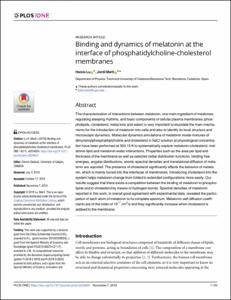Mostra el registre d'ítem simple
Binding and dynamics of melatonin at the interface of phosphatidylcholine-cholesterol membranes
| dc.contributor.author | Lu, Huixia |
| dc.contributor.author | Martí Rabassa, Jordi |
| dc.contributor.other | Universitat Politècnica de Catalunya. Departament de Física |
| dc.date.accessioned | 2020-06-22T08:58:12Z |
| dc.date.available | 2020-06-22T08:58:12Z |
| dc.date.issued | 2019-11-07 |
| dc.identifier.citation | Lu, H.; Marti, J. Binding and dynamics of melatonin at the interface of phosphatidylcholine-cholesterol membranes. "PloS one", 7 Novembre 2019, vol. 14, núm. 11, p. 1-20. |
| dc.identifier.issn | 1932-6203 |
| dc.identifier.uri | http://hdl.handle.net/2117/191282 |
| dc.description.abstract | The characterization of interactions between melatonin, one main ingredient of medicines regulating sleeping rhythms, and basic components of cellular plasma membranes (phos- pholipids, cholesterol, metal ions and water) is very important to elucidate the main mecha- nisms for the introduction of melatonin into cells and also to identify its local structure and microscopic dynamics. Molecular dynamics simulations of melatonin inside mixtures of dimyristoylphosphatidylcholine and cholesterol in NaCl solution at physiological concentra- tion have been performed at 303.15 K to systematically explore melatonin-cholesterol, mel- atonin-lipid and melatonin-water interactions. Properties such as the area per lipid and thickness of the membrane as well as selected radial distribution functions, binding free energies, angular distributions, atomic spectral densities and translational diffusion of mela- tonin are reported. The presence of cholesterol significantly affects the behavior of melato- nin, which is mainly buried into the interfaces of membranes. Introducing cholesterol into the system helps melatonin change from folded to extended configurations more easily. Our results suggest that there exists a competition between the binding of melatonin to phospho- lipids and to cholesterol by means of hydrogen-bonds. Spectral densities of melatonin reported in this work, in overall good agreement with experimental data, revealed the partici- pation of each atom of melatonin to its complete spectrum. Melatonin self-diffusion coeffi- cients are of the order of 10 -7 cm 2 /s and they significantly increase when cholesterol is addeed to the membrane. |
| dc.format.extent | 20 p. |
| dc.language.iso | eng |
| dc.publisher | Public Library of Science (PLOS) |
| dc.rights | Attribution-NonCommercial-NoDerivs 3.0 Spain |
| dc.rights.uri | http://creativecommons.org/licenses/by-nc-nd/3.0/es/ |
| dc.subject | Àrees temàtiques de la UPC::Física |
| dc.subject.lcsh | Membranes (Biology) |
| dc.subject.lcsh | Phospholipids |
| dc.title | Binding and dynamics of melatonin at the interface of phosphatidylcholine-cholesterol membranes |
| dc.type | Article |
| dc.subject.lemac | Membranes (Biologia) |
| dc.subject.lemac | Fosfolípids |
| dc.contributor.group | Universitat Politècnica de Catalunya. SIMCON - First-principles approaches to condensed matter physics: quantum effects and complexity |
| dc.identifier.doi | 10.1371/journal.pone.0224624 |
| dc.description.peerreviewed | Peer Reviewed |
| dc.relation.publisherversion | https://journals.plos.org/plosone/article?id=10.1371/journal.pone.0224624 |
| dc.rights.access | Open Access |
| local.identifier.drac | 28709889 |
| dc.description.version | Postprint (published version) |
| local.citation.author | Lu, H.; Marti, J. |
| local.citation.publicationName | PloS one |
| local.citation.volume | 14 |
| local.citation.number | 11 |
| local.citation.startingPage | 1 |
| local.citation.endingPage | 20 |
Fitxers d'aquest items
Aquest ítem apareix a les col·leccions següents
-
Articles de revista [2.208]
-
Articles de revista [383]


